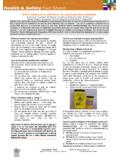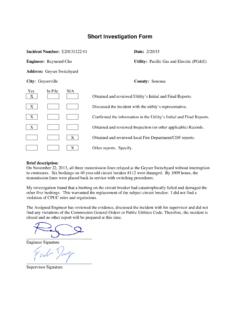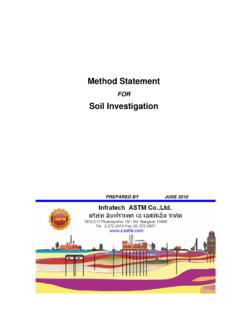Transcription of Health and Safety Incident Investigation
1 Health AND Safety Incident Investigation . Guideline to conducting an Investigation into a Health and Safety Incident Organisational Health Department of Education and Training Reviewed:January 2012. V3 Uncontrolled when printed Introduction The Department of Education and Training has a duty under the Work Health and Safety Act 2011 to ensure where reasonably practicable, the Health and Safety of employees, students and other persons by identifying hazards, assessing risks that may result because of the hazards and deciding on appropriate control measures to prevent or minimise the levels of risk. To fulfil this duty the department is committed to investigating Health and Safety incidents. When a Health and Safety Incident occurs within a workplace, a thorough Investigation assists in determining the cause of the Incident and allows for corrective action or so lutions to be implemented.
2 This is to prevent the recurrence of the Incident and to minimise or eliminate any current or future risk. It is important to remember that Health and Safety investigations are never conducted, under any circumstances, to apportion blame or liability for what occurred. A Health and Safety Investigation must be a no blame Investigation . The scope and complexity of any Health and Safety Investigation should mirror the actual or potential seriousness of the Incident . To assist employees in determining the seriousness of an Incident the department has established the following four classes to assist in the classification of a Health and Safety Incident . Class A Class B Class C Class P Serious injury Injury Minor injury Psychological-related Dangerous Incident Near miss or or Incident injury Work caused illness Serious electrical Incident potential event [Refer to HLS-PR-019: Health and Safety Incident Investigation for further class definitions] While every endeavour should be made to attend the Incident scene as soon as possible in order to commence the Investigation (or immediately as in the case of a Class A Incident ), it is understandable that in some regional circumstances this may not always be practicable.
3 In circumstances where the appointed Health and Safety investigator is unable to immediately attend the scene of a Class A Incident , it may be necessary to contact the officer in charge of the workplace and request arrangements for photographs to be taken and witnesses identified. Organisational Health Department of Education and Training Reviewed:January 2012. V3 Uncontrolled when printed Investigation Process The Investigation process consists of seven steps: 1. Immediate Action 2. Plan the Investigation 3. Collect Information 4. Organise Information 7. Report Outcomes 6. Recommend Solutions 5. Analyse Information Step 1: Immediate Action When appointed by a supervisor to undertake the Investigation of a Health and Safety Incident , dependant on the severity of the Incident , it may be necessary to take so me immediate action.
4 If the Incident has just occurred it is important to go immediately to the Incident scene to consider the following requirements: Does anyone require medical attention? If so, make sure the appropriate medical attention is being or has been arranged. How can the Incident scene be secured and taken control of? This may involve erecting barricades, turning power off, evacuating people, etc. Are there any hazards, that pose a danger to yourself or other persons, that need removing? Make sure you document or photograph the location of the hazard prior to its removal for future reference. Was any equipment involved in the Incident ? If so, tag it as out of order . Were any departmental vehicles involved in the Incident ?
5 For example, a school tractor or ride-on mower. If so, impound them. Does any individual ( Principal, Regional Health and Safety Consultant) or organisation ( Workplace Health and Safety Queensland) need to be informed of the Incident ? Organisational Health Department of Education and Training Reviewed:January 2012. V3 Uncontrolled when printed Step 2: Plan the Investigation Start the Investigation by preparing a simple Investigation plan outlining what steps are to be taken to successfully conduct the Investigation . Use a diary or notebook to record what actions are undertaken. Consider: What is the time frame for the Investigation ? Who do I need to speak to? Write down the actual names of the people you need to speak to.
6 Writing witnesses is not enough because by tomorrow you might not recall who the witnesses were. Does anything need to be photographed? If items require photographing, either take the photographs immediately and make a note in your Investigation plan that you have done so or make a note of what needs to be photographed so that you remember to come back and do it. Do you need to draw a sketch plan of the Incident scene? If you take photographs, it is a good idea to draw a simple sketch plan showing where you took the photographs. What other documents need to be collected or sighted? For example, risk assessments, hazard registers, procedures. Who do I report the Investigation findings to? Having a simple plan or checklist helps to ensure nothing is overlooked.
7 As an investigator, always be objective and keep an open mind. In particular, do not assume; outcomes must be based on info rmation which is known to be accurate and complete. Step 3: Collect information If you attend an Incident scene shortly after the Incident has occurred, or if the Incident scene has been preserved, spend a few moments observing the scene. This can provide you with valuable information. Consider the following issues: the date, time and location of the Incident the people involved any known events leading up to the Incident Organisational Health Department of Education and Training Reviewed:January 2012. V3 Uncontrolled when printed what was happening at the time of the Incident weather conditions.
8 Depending on the Incident , you may be required to collect information relating to one or all of the following areas: You should record all of your activities, interviews and notes in the same diary or notebook as your Investigation plan. Organisational Health Department of Education and Training Reviewed:January 2012. V3 Uncontrolled when printed Conducting interviews Make sure you conduct your interviews as soon as possible after the Incident . This will include talking to witnesses, the injured person/s, others involved in the Incident , supervisors and persons in control of the workplace. Make it clear that your purpose for investigating the Incident is to find out why it happened in order to prevent similar incidents from happening in the future.
9 If any witnesses are reluctant to speak to you, assure them that your Investigation is not attempting to apportion blame or liability. If possible, speak to witnesses at the scene. Research shows that a person s recall diminishes as time goes on. Speak to people separately. Make sure, where possible, that witnesses can discuss the Incident with you in relative privacy. Allow support persons to be present, but remember that a support person sh ould not be a witness or directly linked to the Incident and sh ould not participate in the discussion about what occurred. Always use simple language and avoid acronyms. After speaking to a person, repeat what they said to ensure you have correctly recorded their version of events.
10 Most importantly, close each interview on a positive note. In your interviews, you want to obtain all the facts who, what, where, when, why and how. Don t assume anything get clear and concise answers. To do this, you will need to ask open questions to get initial information and then use closed questions to clarify ambiguity. Avoid asking leading and multiple questions. Open questions Use open questions to encourage the person to say what s on their mind. This will help you to obtain their personal opinion of what happened, without any unintended influence from the question. Asking open questions means that you will only receive information about what the respondent actually saw or knew other types of question can put ideas into people s minds.
















